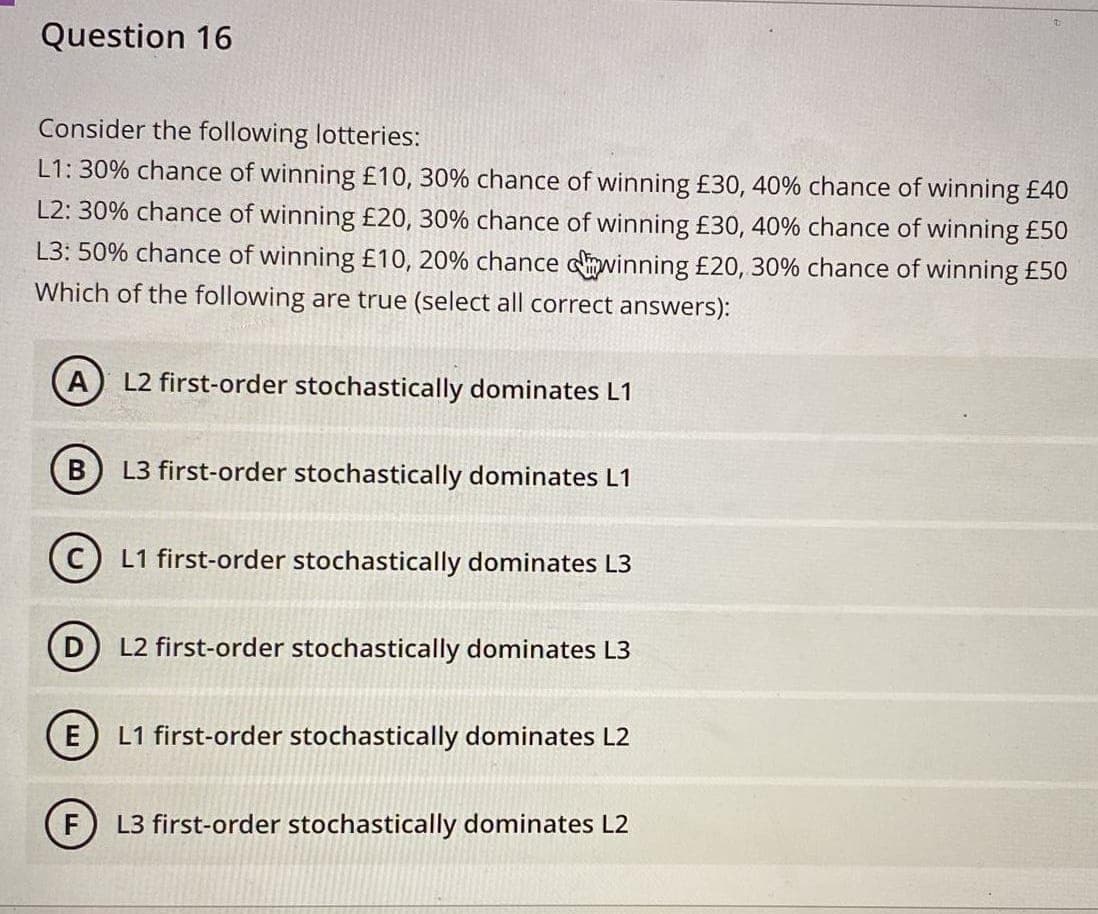Question 16 Consider the following lotteries: L1: 30% chance of winning £10, 30% chance of winning £30, 40% chance of winning £4 L2: 30% chance of winning £20, 30% chance of winning £30, 40% chance of winning £5 L3: 50% chance of winning £10, 20% chance winning £20, 30% chance of winning £5 Which of the following are true (select all correct answers): B D E L2 first-order stochastically dominates L1 L3 first-order stochastically dominates L1 L1 first-order stochastically dominates L3 L2 first-order stochastically dominates L3 L1 first-order stochastically dominates L2 F L3 first-order stochastically dominates L2
Question 16 Consider the following lotteries: L1: 30% chance of winning £10, 30% chance of winning £30, 40% chance of winning £4 L2: 30% chance of winning £20, 30% chance of winning £30, 40% chance of winning £5 L3: 50% chance of winning £10, 20% chance winning £20, 30% chance of winning £5 Which of the following are true (select all correct answers): B D E L2 first-order stochastically dominates L1 L3 first-order stochastically dominates L1 L1 first-order stochastically dominates L3 L2 first-order stochastically dominates L3 L1 first-order stochastically dominates L2 F L3 first-order stochastically dominates L2
Elementary Linear Algebra (MindTap Course List)
8th Edition
ISBN:9781305658004
Author:Ron Larson
Publisher:Ron Larson
Chapter2: Matrices
Section2.5: Markov Chain
Problem 36E: Customer Preference Two movie theatres that show several different movies each night compete for the...
Related questions
Question

Transcribed Image Text:Question 16
Consider the following lotteries:
L1: 30% chance of winning £10, 30% chance of winning £30, 40% chance of winning £40
L2: 30% chance of winning £20, 30% chance of winning £30, 40% chance of winning £50
L3: 50% chance of winning £10, 20% chance winning £20, 30% chance of winning £50
Which of the following are true (select all correct answers):
A L2 first-order stochastically dominates L1
B
C) L1 first-order stochastically dominates L3
E
L3 first-order stochastically dominates L1
F
L2 first-order stochastically dominates L3
L1 first-order stochastically dominates L2
L3 first-order stochastically dominates L2
Expert Solution
This question has been solved!
Explore an expertly crafted, step-by-step solution for a thorough understanding of key concepts.
Step by step
Solved in 8 steps

Recommended textbooks for you

Elementary Linear Algebra (MindTap Course List)
Algebra
ISBN:
9781305658004
Author:
Ron Larson
Publisher:
Cengage Learning

Algebra & Trigonometry with Analytic Geometry
Algebra
ISBN:
9781133382119
Author:
Swokowski
Publisher:
Cengage


Elementary Linear Algebra (MindTap Course List)
Algebra
ISBN:
9781305658004
Author:
Ron Larson
Publisher:
Cengage Learning

Algebra & Trigonometry with Analytic Geometry
Algebra
ISBN:
9781133382119
Author:
Swokowski
Publisher:
Cengage
